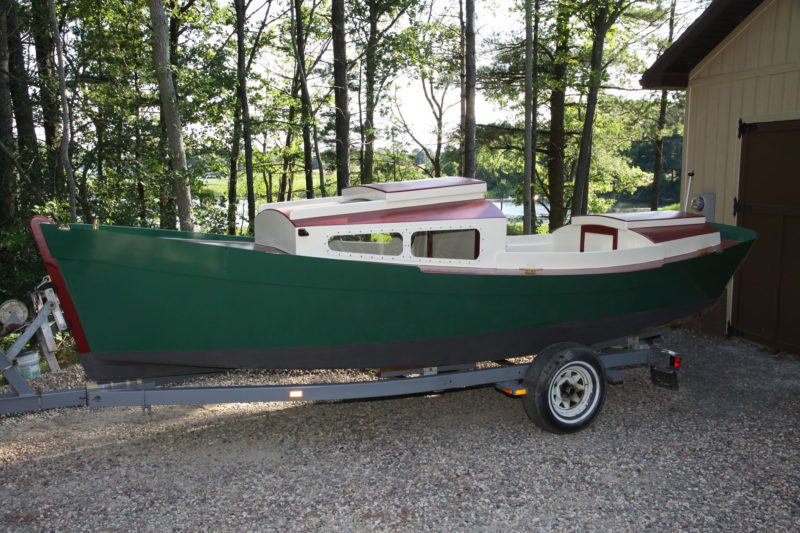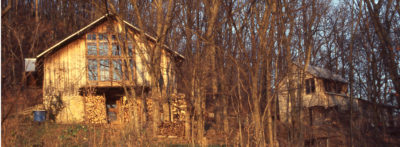 photographs courtesy of the Dusharms
photographs courtesy of the DusharmsSTILL THINKING is a Redwing 18, and Barry Dusharm’s first power boat.
Barry Dusharm grew up with boats, logging a lot of hours paddling and rowing. The passion for being on the water never left him, and when the obligations of a career and family allowed, he built a 17′ stitch-and-glue light dory and made a circumnavigation of sorts of northern New York State. He rowed south along Lake Champlain, west on the Erie Canal, trucked around Niagara Falls, and carried on rowing the southern shore of Lake Ontario. He descended 100 miles down the St. Lawrence, keeping to that river’s American shore until the Canadian border blocked his way. His wife Leslie did the driving for the half dozen legs of the trip, shuttling him back and forth as he juggled rowing and work.
Barry had gone through some rough patches of water on Lake Ontario. Rowing an open boat in big waves worried him, and he began thinking about a kayak with watertight compartments that would keep him safe in bigger water. He didn’t want to give up rowing, the carrying capacity, and range of his dory, so he created a hybrid, combining the hull of a 21′ stitch-and-glue kayak hull with a cockpit for sliding-seat rowing with decks that created watertight storage compartments and housed foam flotation in both ends. With this new boat he took multi-week trips in the Florida Everglades, Arizona’s Lake Powell, and twice rowed Québec’s Manicouagan Reservoir, a circle of water 40 miles in diameter created by a meteor that smacked Canada 215 million years ago. For less ambitious outings he built a Wee Lassie canoe for himself to explore the waters in and around New York’s Adirondack Park.
When their two daughters went off to college, Barry and Leslie built a new home in New York on the Chaumont River, just 2 miles up from Chaumont Bay on the eastern end of Lake Ontario. With the river and lake so close by, it was natural for Barry to begin thinking about building another boat and about adding a shop to the new home to build the boat in. The boat that came to mind was the Karl Stambaugh’s Redwing 18. In 2004 Barry had read about the boat in a series of how-to-build articles in WoodenBoat magazine, and the following year he had seen the boat and met its designer at The WoodenBoat Show in Mystic, Connecticut. Barry’s boatbuilding experience had given him a glimpse of what was involved in building the Redwing, but he had never driven a powerboat before, let alone owned one.

With the building form on wheels, the hull could be moved to provide better access in Barry’s small garage.
While the Dusharms were making plans to build the new house, Barry happened upon a Redwing listed in a Vermont Craigslist ad. “Call for details,” the ad read. Barry didn’t call, but mentioned the ad to his wife. Rather than engaging in a discussion about the financial burdens of two kids in college and building a new home, Leslie said, “Isn’t that the boat you keep talking about? How much do they want?”

The Redwing 18 tips the scales at around 1,200 lbs.
That weekend Barry drove to Vermont with an empty boat trailer. The Redwing wasn’t really a boat, but the parts for one. The owner had ordered a CNC-cut kit a few years earlier and made a tentative start before abandoning the project. The pile of plywood had been in a barn, out of the weather, and had collected a thick layer of dust and pigeon poop. Barry loaded the plywood, 8 gallons of epoxy resin, 8 quarts of hardener, fillers, cups, and scrapers and headed home.

The Redwing can be built with the wheel and controls on the motor well, but Barry chose to put the helm forward to put his boat in better trim.
The kit went into storage for a year and a half while the Dusharms built their new house. Barry got his new boatshop, a 15′ x 30′ heated addition to the garage, and at last went to work on the boat. He spent two-and-a-half years building his Redwing. He gave it some special touches—homemade ash cleats, a brass bit on the foredeck, and a ship’s wheel he picked up at a flea market and invested a week’s worth of work to restore.

The enclosure for the 9.9-hp outboard keeps the cockpit remarkably quiet.
Barry’s research had led to reports from Redwing owners about steering issues. With Stambaugh’s blessing, Barry trimmed the skegs, made additions to the keel, and moved the steering station forward. The modifications would later prove successful in improving trim, tracking, and steering.

Under the hood, there’s a 9.9-hp outboard. The plans for the Redwing recommend a power plant of 5 to 10 hp.
When the Dusharms launched their Redwing last August, Barry christened it STILL THINKING, the reply he’d give Leslie when she asked if the boat would be the last he’d build. The boat’s admittedly spartan cabin provided a degree of luxury Barry had never had aboard his previous boats—shelter from rain and bugs, a bed, a Porta-Potti—and the enclosure for the outboard is so effective that it’s hard to tell the motor is running. When STILL THINKING is underway, doing about 6 mph, the motor burns only a quart of gas per hour. Her shoal draft gives her access to the thin waters Barry favored in his rowing boats. Best of all, STILL THINKING has plenty of room for two and Leslie is able to join Barry on the water.

The low cabin roof offers an unobstructed over the bow; the cabin has room for a small V-berth, galley, and head.
The Ducharms have explored the Chaumont River and Chaumont Bay, and the St. Lawrence River, and have plans to travel the Erie Canal and visit New York’s Finger Lakes. Barry isn’t the only one who knows one boat inspires the next; Leslie’s also “still thinking,” and wondering how big a boat they can build in their shop.![]()
Have you recently launched a boat? Please email us. We’d like to hear about it and share your story with other Small Boats Monthly readers.












Nicely done!
I love the name STILL THINKING. I’ve been thinking about starting a boat build for a lot of years, and Stambaugh’s Redwing is one of the designs on my short list. At my age, it’s probably time to stop thinking and start building.
Thanks for the kind words. I thoroughly enjoyed the build process, even when I had to slow to a crawl while I figured out the next step. The satisfaction of cruising along in a boat where you know the location of and purpose for every screw and piece of wood is immense! Don’t be afraid to start—the learning curve is steep, and all you really need are basic skills and space. If anyone is considering a Redwing build, or has more technical questions about the modifications I incorporated, I am happy to correspond. Please direct your emails to the editor ([email protected]) and he’ll forward them.
That boat would be great to use on our rivers in São Paulo State, Brasil.
Barry, she is just beautiful. Well done!